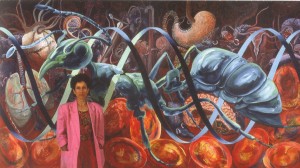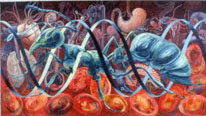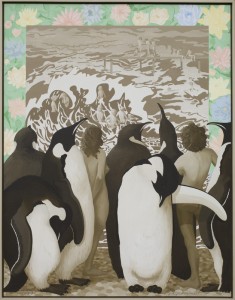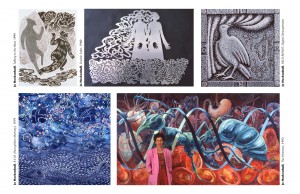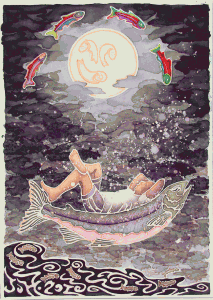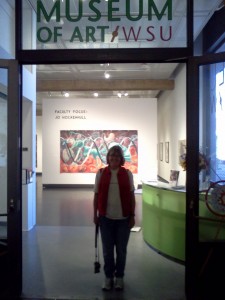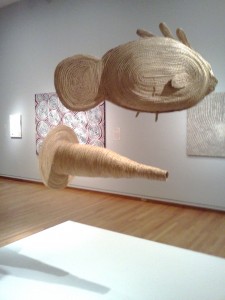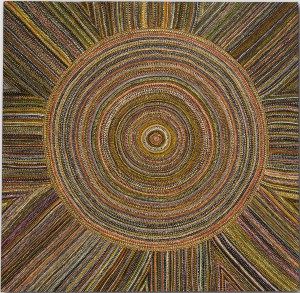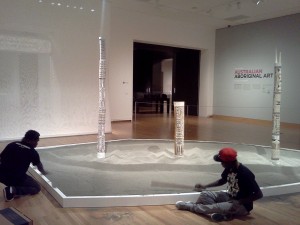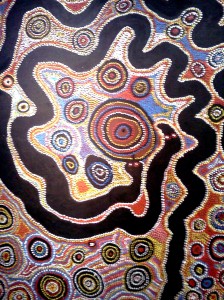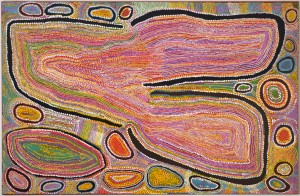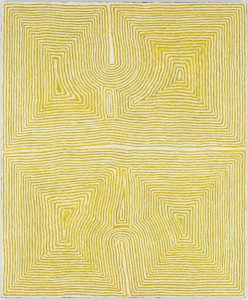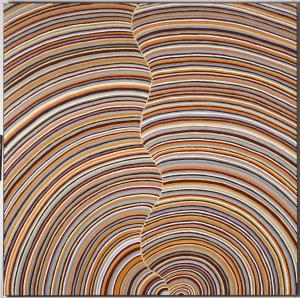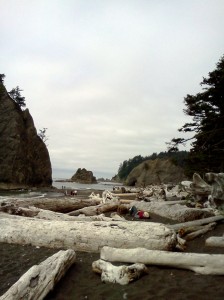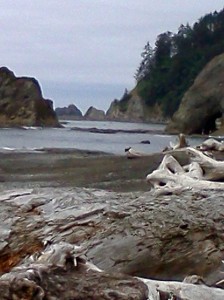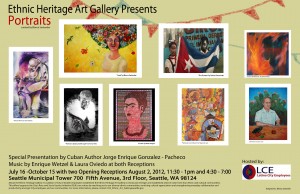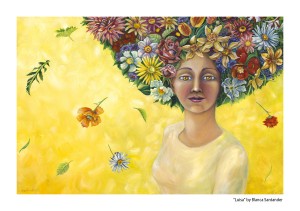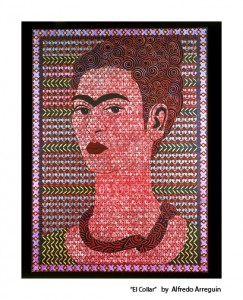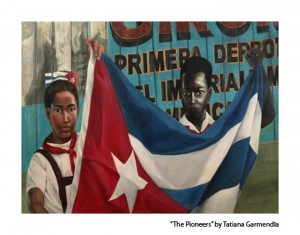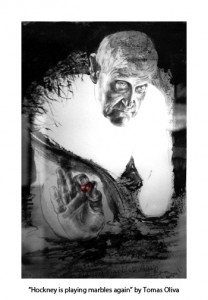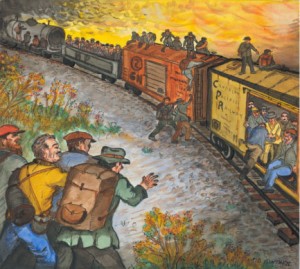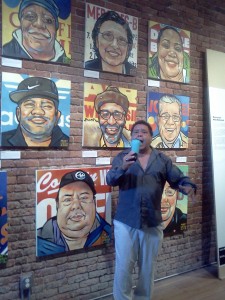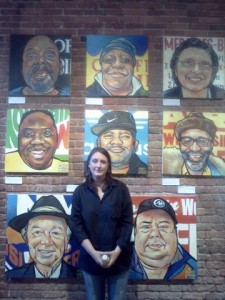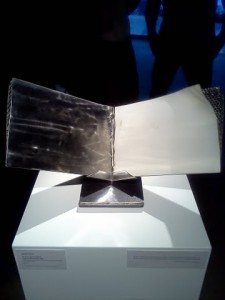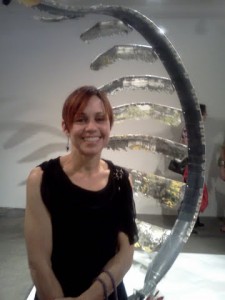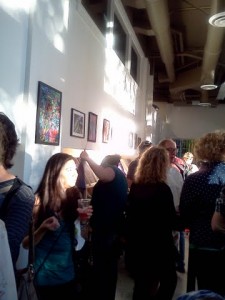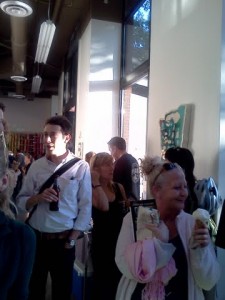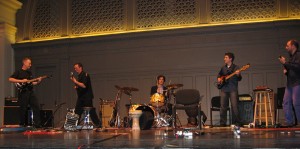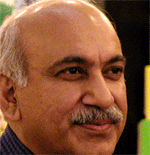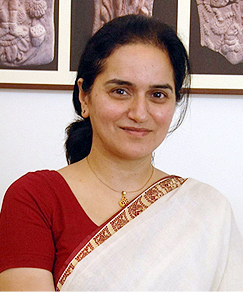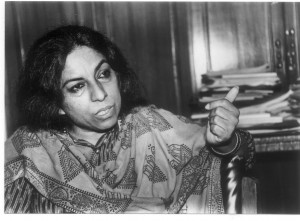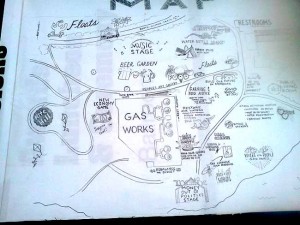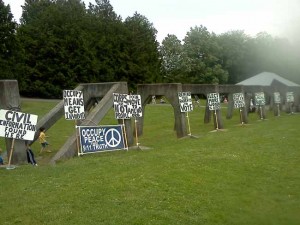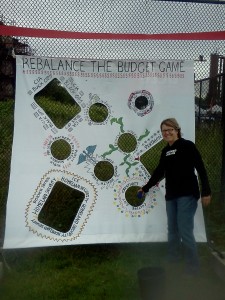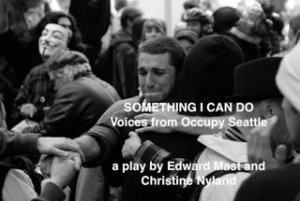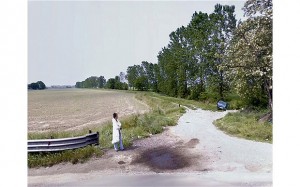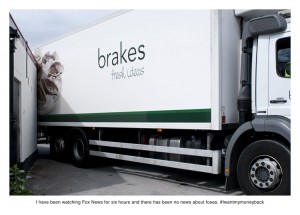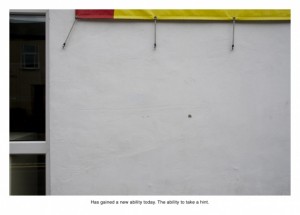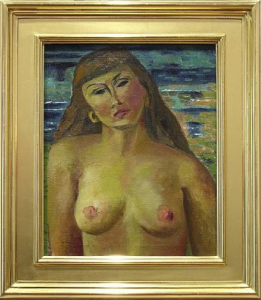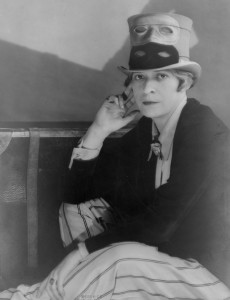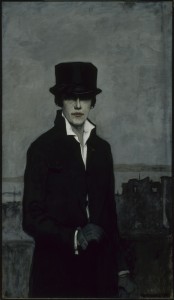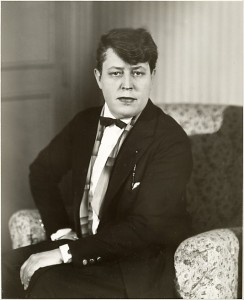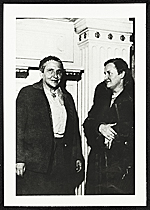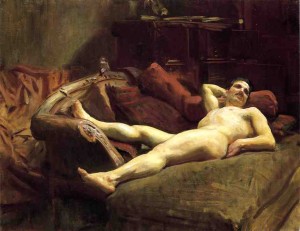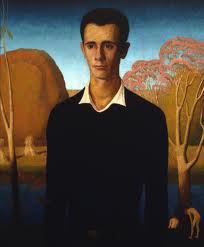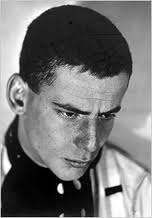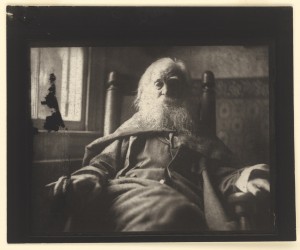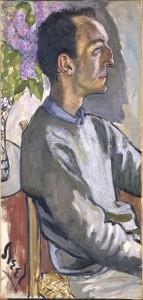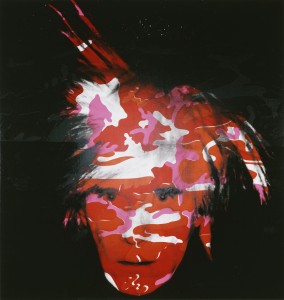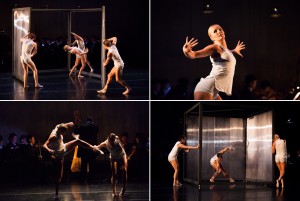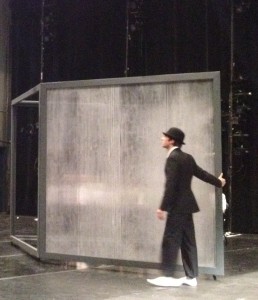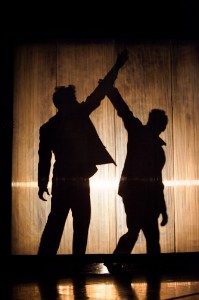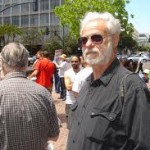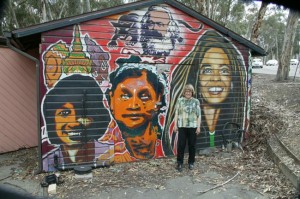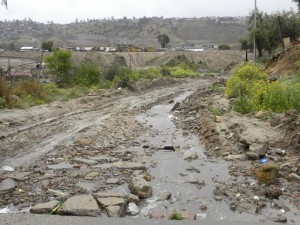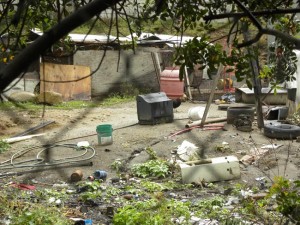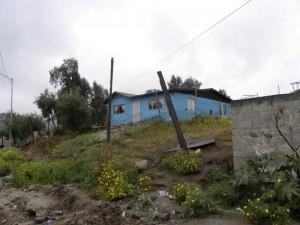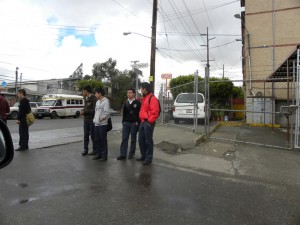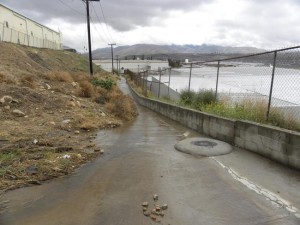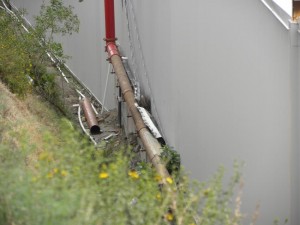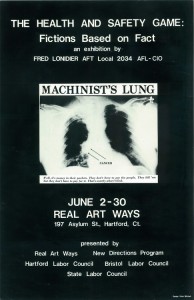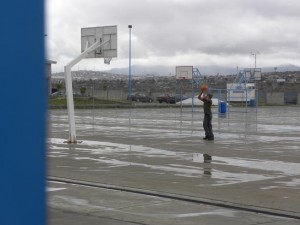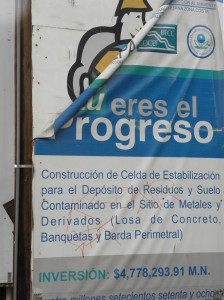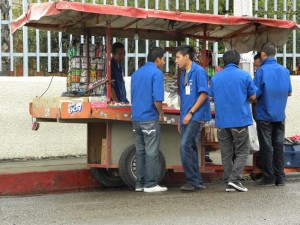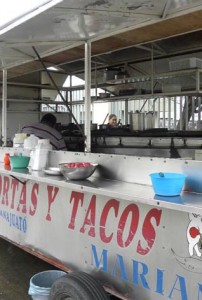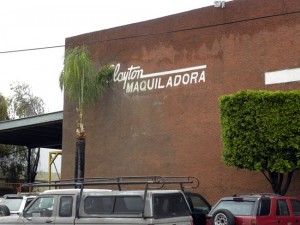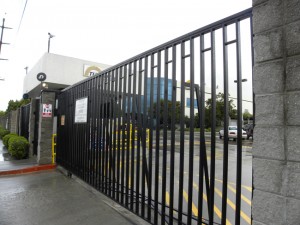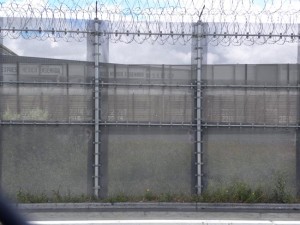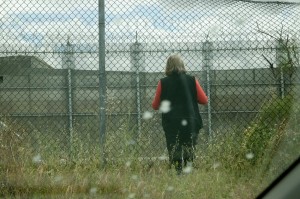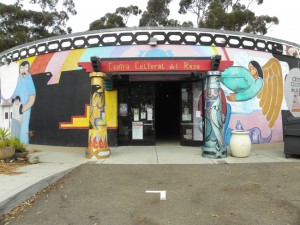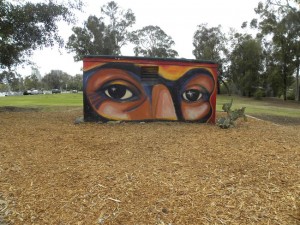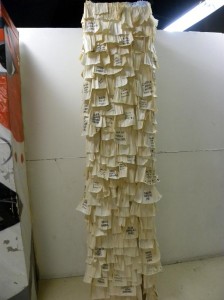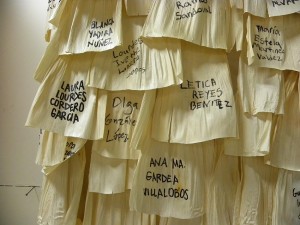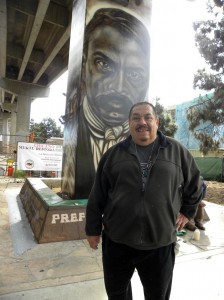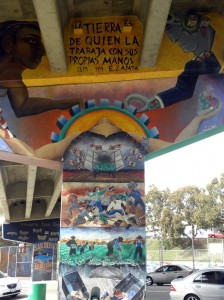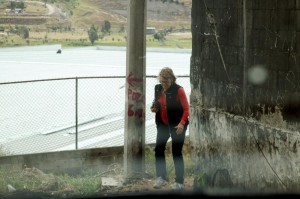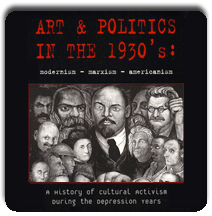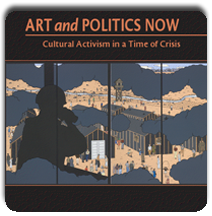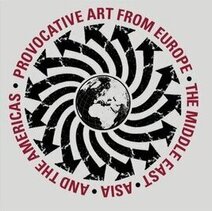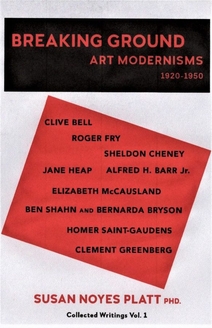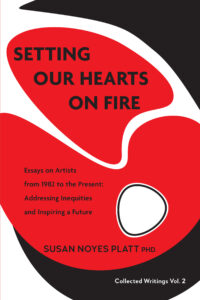The Inheritors: An Exhibition by Jo Hockenhull
We are embedded in the natural world inside and out, organs and bones; we are in and of the bird world, the animal world, the world of insects; some of those creatures are going to survive the human species, in the end because of our obliviousness to our place in the world.
That idea is a major theme of Jo Hockenhull’s career survey at the Washington State University Museum in Pullman, Washington. Hockenhull, a professor of art at Washington State University for many years, has roots in printmaking, but this exhibition demonstrates that she never stands still. Her work ranges from small prints to huge oil paintings, steel cut sculptures, works that evoke the arts and crafts movement in tones and density, and paintings that allude to the disjunctions of humans and the rest of the natural world using digitally generated images placed in the midst of expressive renderings of rats.
In The Inheritors, she focuses on giant ants, with DNA helixes winding through them. Below are large transparent eggs with fetuses. Behind the ants are accurate renderings of various organs, liver, heart, kidney. In her lecture Hockenhull spoke of how ants, who have captivated her for years, will survive after we are all gone. These huge insects are indeed the inheritors of our careless wasting of our complex planet.
Hockenhull’s watercolors are stunning. The early Penguin Nostalgia with a man and woman rendered with a sensuous contrapposto worthy of Botticelli, together with seven delightfully rendered penguins (obviously based on close observation of the behavior of these wonderful creatures), seem to be gazing at a display at an aquarium in which a turbulent sea tosses cherubs. The mid size scale of this work, makes it possible for us to feel as though we are also viewing this unusual display, although from a distance.
Many of Hockenhull’s ink drawings, done as illustrations for books, are small, with a subtle black and white decorativeness, have a strong force that counters the decorative qualities with charged purposefulness.
Yet another entirely different aesthetic is the imitation stone low relief paintings, many of them birds, another passion of the artist. She was inspired by low relief imagery in stone, but her reliefs, which can be independent square paintings, or a type of bas relief under a larger painting in a different style, all are her own personal interpretation of that ancient approach to imagery. (Upper right image below)
Hockenhull never stops exploring. I wished sometimes we could have seen more of a particular idea ( as in her Past Present Future series with the word Future crossed out, or the subtle series of paintings Sentinel Singers, inspired by Chinese funerary stele). Her interest in science comes through clearly in the large scaled xray series which were given a coherent display at the center of the exhibition. But frequently, chronology, media, and themes were broken up in the installation, disrupting our ability to follow ideas. With an artist of this intensity, that was not helpful. But nonetheless, the exhibition is an inspiration as a demonstration of the ways in which an artist can pursue multiple directions. So often today, we have the opposite, one direction, one style, one statement repeated over and over.
The theme in this retrospective is humans and nature, their interactions, their collisions, their contradictions, their connections. This recent watercolor, Beginner’s Creek, suggests one possibltity for our peaceful future, returned to the embrace of the natural world.
Get Pullman on your fall travel map and see this exhibition!
This entry was posted on September 10, 2012 and is filed under Art and Activism, Art and Ecology, Art and Politics Now, Uncategorized.
The Pinter Festival at ACT
This is just a quick acknowledgement of a brilliant playwright and a thank you to the ACT theater for staging a Pinter Festival this summer. Harold Pinter stylistically can be placed between Samuel Beckett and Tom Stoppard in the British Theater. He lived from 1930 – 2008 and received the Nobel Prize for Literature in 2006. I quoted from one of his anti war poems “God Bless America” (2003) at the beginning of my book Art and Politics Now. It was written at the beginning of the Iraq war.
“Here they go again
The Yanks in their armored parade
Chanting their ballads of joy
As they gallop across the big world
Praising America’s God
The gutters are clogged with the dead.”
His Nobel Prize lecture in 2005 was absolutely bald in its condemnation of the US policies since World War II. Pinter’s command of language is such that the speech “Art Truth and Politics” is riveting. He begins with some brief references to several of his plays; the theme of all of them is possibilities, ambiguities, and the “search for truth” which “can never stop,” as he said.
Indeed the four plays recently presented by ACT theater,
Old Times, The Dumb Waiter, Celebration and No Man’s Land, as well as the monlogue by Henry Woolf, who was Pinter’s closest friend throughout his life, all are populated by characters who are speaking what they think is truth, but truth that is memory, fantasy, hopes, dreams, and invention. The characters do not communicate with each other, they seem to talk beyond or through each other ( in the case of Woolf’s monologue he is actually talking to an empty chair). The famous Pinter pauses emphasizes the lack of communication. The silences in Pinter’s plays say as much as the words. ( I found myself craving pauses after seeing his plays.)
His plays are located in the living rooms, restaurants, and sometimes basements of the middle class. His characters are usually doing nothing but talk, there is no action, no plot, no story, except what the characters narrate as they basically sit in one place, with a few actions ( pouring coffee, pouring scotch) to punctuate the speeches. We can hear Shakespeare, Beckett, T.S. Eliot, the whole of English literature in these speeches. They are elegant, circuitous, and fantastically long. The other characters stand in suspended animation, with just slight changes in facial expressions, as the speaking character holds forth.
It is a completely unpromising format.
Pinter does not address anything political in his plays directly (unlike Stoppard). He prefers to lay out the tapestry of words that suggest the human soul at its most poignent and vulnerable. Since he deeply cared about language as a crucial human attribute, the forming of words, ideas, thoughts, was difficult and necessary; it follows then that, for him, the corruption of language by politicians is a manifestation of the death of humanity.
Pinter saw how language was being used to tell lies about Iraq, he spoke out against it. He saw how the language of the US presidents and government, words like democracy and freedom, have always been used to justify atrocities.He saw through all the language screens because he constructed so many of them himself. But his screens are full of humanity, love, and aspiration. The screens of politicians are manipulative, devious, and malignant.
In his Nobel prize speech Pinter speaks of the language of politics and its absence of truth.
” . . . the majority of politicians, on the evidence available to us, are interested not in truth, but in power and in the maintenance of that power. To maintain that power it is essential that people remain in ignorance, that they live in ignorance of the truth, even the truth of their own lives. What surrounds us therefore is a vast tapestry of lies upon which we feed.”
When we view his plays, we feel claustrophobic, we feel trapped in a small space, but we slowly realize that the only escape is through language, words that expand that space, that define the individuals, that reach backward in time and forward into the future. From those armchairs, we experience a sensation of the human spirit taking flight though imagination.
That is why we feel so trapped today, because the language of the public arena does not allow any escape, it is fantasy without any basis in humanity.
It is fabrication created in order to destroy, kill, and gain power. We live our lives, our ordinary lives, against a backdrop of massive delusional power that is undermining everything we care about, that is physically destroying our country, not in the same way that we are destroying other countries, but just as relentlessly. Why on earth do we have so many homeless, so many without jobs, without health care, so many without any way to go forward, such struggling schools, as we pour resources into war and weapons making.
Here’s to Pinter, one of the great writers and thinkers to bring together art and politics through his extraordinary command of the English language and all of its nuances. And it is the absence of nuance that he saw as the most revealing of the deadly goals of political discourse. For Pinter, lack of nuance means, lack of imagination, lack of thought, and in the end, lack of life.
This entry was posted on August 27, 2012 and is filed under Art and Activism, Art and Politics Now, Uncategorized.
Aborignial Paintings Preserve Ancestral Dreams and Maybe the Future as Well
In case you wish you were out of the city, for only another two weeks ( until Sept 2), you can take a vicarious trip to the Australian deserts and shores at the Ancestral Modern Exhibition at the Seattle Art Museum.
The exhibition is filled with sweeping paintings and dramatic sculptures. Many appear abstract, but actually depict insects, animals, birds, vegetation, people, and land forms. These are no empty deserts! They are rich with rock holes, sand hills, bush foods ( raisins, edible mushrooms, fruits, grubs, vines, bananas, yams and much more). We see lizards, geese, shark, whale, crocadiles, kangaroos, possum, wallaby, and also people (usually represented by an abstract shape). These paintings also use ancient and contemporary symbols to tell stories, often stories that are morality tales of appropriate behavior.
The sense of color, abstract shapes, scale, stroke, texture is a feast for the eyes, but the stories, fables, and dreams are a feast for the spirit.
These artists believe that the land owns them rather than the other way around. We feel their reverence as we look at these paintings.
In the photograph above, taken at the press preview, two young aboriginal artists are creating a sacred space in the first room of the exhibition.Ismail Marka and Jamie Widenmeier travelled from Australia to make sure that the more than 100 paintings and sculptures from the Levi and Kaplan Collection (a promised gift to the museum), would be appropriately introduced with a sacred space.
They created an elliptical boat- like shape in the sand. This boat represents where life and death intersect. In the boat are three hollow eucalyptus logs, each carved by a different artist and filled with symbolism. These logs are the traditional burial site for the bones of a deceased person in Amhem Land. Near it is a video of a dance Yingapungapu envisioning the passage between life and death.
Another painting by a collaborative group of men, the Spinifex Men’s Collaborative is called Two Men Story. This work is one of many conceptual maps created as symbolic title deeds in a native title claim to land in West Australia in the Great Victoria Desert. It includes the story of an old snake deep under ground and father and son snakes who journey through the desert.
The details of the painting represent land forms as well as snake tracks, and ancestral myths. But this painting adds another layer to the story. The Aboriginal peoples were forced off of this land by nuclear testing and the snakes are also the tire tracks of the trucks that took them away from their land. Today, the land is, apparently, once again inhabitable. But those black tracks reach into prehistory to represent a frightening snake, and into the present to represent the invasion of people who destroyed the land.
Most of the paintings do not refer to destruction, but all of them are acts of cultural preservation, an effort to make sure that their culture does not disappear. Ricky Maynard of the Wik people, declared in 2001
“to know the meaning of culture you must recognize the limits and meaning of your own. You can see its facts but you cannot see its meaning . We share meaning by living it. Wik people have been fighting for decades for their country [ their rights were recognized in 1996] – this passage of time has come at a high cost in denial, depression and death. How could we even begin to understand the suffering – yet the people still continue with their strong beliefs of spiritual ancestry and dreaming.”
And dreaming is the overarching theme of the entire exhibition. Many of these paintings are dreams, not only of people, but of a creature like the crocodle, or a potato bush, or a kingfisher or an old woman.
The aboriginal artists today are creating within the longest enduring culture on the planet; they remind us of how short has been the times of destruction, our extract culture. If only we could listen to the stories and dreams of these paintings and give into to the land, instead of believing we can use it or exploit it, perhaps we have a future.
Something will survive our current era, but it may not be the human race. Much more likely is the extraordinary thorny devil lizard who survives in the harsh desert of Australia by drinking the dew that lands on its own spikes.
The alternative reality represented by these artists is compelling They may perhaps be showing us another means of survival. They see in a desert many types of food as well as watering holes, rather than desolation or monetary wealth. Their homes are the land, rather than a structure built on top of the land, If we can learn from that, perhaps we can survive also.
This entry was posted on August 16, 2012 and is filed under a green future?, Art and Ecology, ecology, Uncategorized.
Reading Poetry while on a Camping Trip
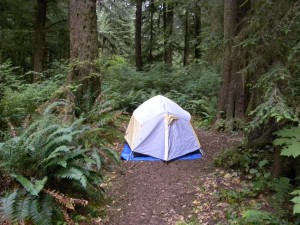 One of my favorite activities is to read poetry out loud to my camping partner, or to myself, in the woods, when my mind is cleared of the distractions of electronics, life’s petty minutiae, and its big struggles, not to mention the news.
One of my favorite activities is to read poetry out loud to my camping partner, or to myself, in the woods, when my mind is cleared of the distractions of electronics, life’s petty minutiae, and its big struggles, not to mention the news.
What is left is resting my eyes on a non linear forest, large old growth trees following their own way in the forest, with lush green ferms and other undergrowth filling the rest of my vision. Or allowing the logs of the beach to overwhelm me with their unexpected arrangements. Sculptors must always despair when they look at nature. How can they possibly compete.
Or gazing far out to sea and adjusting to subtle shades of grey, silver, and tawny browns on an overcast day (much more restful than sunshine). Although on this trip I was overcome with sadness, as I looked at the petrified trees (ancient enormous trees whose roots are like huge snarling birds or beasts or smaller, smoother pieces that are calm resigned sea otters and bears) warning us of the apocalypse we are creating on our planet. In their whiteness, barely emerging from the sand, is the end of our world.
So,to return to my theme, I took three types of poetry on this trip,
First I had
Beloved Community, the Sisterhood of Homeless Women in Poetry, poetry by women who are or were homeless , some of the poems the result of workshops run by SHARE/WHEEL, an empowerment project for homeless women. SHARE stands for Seattle Housing and Resource Effort, WHEEL stands for Women Housing and Enhancement League. The link is to an excellent review with several quotes from the poets.
Second I had
the most recent issue of Calyx, a Journal of Art and Literature by Women that has been going for 36 years and just has transitioned to a new editor very successfully. This journal has poetry, short fiction, art work, and in this issue interviews and a essay honoring Audre Lorde. Here is a link to an excerpt.
Third I had
The most recent issue of the New Yorker, which had only two poems. one called The Cello by Ruth Padel , and Eggs by Kay Ryan, coincidentally both women.
So all of this was poetry by women.
As I read some random poems in Beloved Community, about being cold, about being in the street, about being on the edge of life, all of the words were strong, all of the images clear. It was really affecting.
As I read the poetry from Calyx about women at different stages of their lives, experiencing various crisis or change, I was also deeply affected. I felt a sense of beauty and deep feeling in these poems.
As I read the two poems from the New Yorker, the pinnacle of publishing for a poet, I had to read them over and over. The first one called The Cello by Ruth Padel was full of images that, for me, didn’t cohere. The second, Eggs, by Kay Ryan, was much more compelling, short, coherent, and full of a sense of profound loss. But no stronger in its emotion than many of the poems in Beloved Community or Calyx.
This blog, Art and Politics Now, is dedicated to celebrating women who are homeless and overcome life’s adversity to write poetry, or women who are less known and will probably never publish in the New Yorker but who have a voice that sings. One of the two poets in the New Yorker, Kay Ryan, has won a Pulitzer prize and been poet laureate of the US, She is definately a great poet and I will read more poems by her.
But overall, I want to emphasize that ordinary people are brilliant, but they don’t have time to think about it, because they are just filled with the act of getting through their lives.
As my friend Anitra Freeman (one of the poets in Beloved Community and an editor of Real Change News, another homeless empowerment project) declared, it makes you really sad to think of all the amazing talent that is lost because of life’s difficulties. Among the homeless population are many many poets. Among the population in general are many poets. The tiny group that publish in the New Yorker are accomplished poets, but they are certainly not the only ones!!!!
This entry was posted on August 9, 2012 and is filed under Art and Politics Now, Poetry, Uncategorized.
A Remarkable First Thursday in Seattle
Last night I started at the Ethnic Heritage Art Gallery in the Seattle Municipal Building on the third floor. The exhibition “Portraits” curated by Blanca Santander included works by herself
Fulgencio Lazo, GLoria Ruiz, Jose Orantes, Rene Julio,
and Tomas Oliva.
I talked to several of the artists. The theme of Portraits was strikingly developed in a lot of different styles. I am providing links above to artists with web sites.
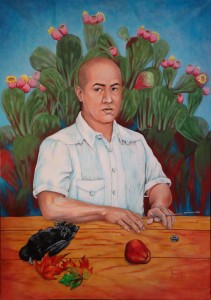
Rene Julio’s Immigrant was a self portrait. I discovered that he is mainly a mural artist, with striking murals in various restaurants in the Seattle area.
These artists are, of course, well known in Seattle, some more than others. What is intriguing is that the need for an Ethnic Heritage Gallery is still with us. Preston Hampton, assisted by a team of curators, all employees with the city created this gallery out of whole cloth. Preston got some space and the Gallery now has four shows a year, representing different ethnic groups. The exhibitions include major artists as well as emerging artists.
From there we went to the “Skid Row” exhibition at OlsonKundig Architects StoreFront. According to their press release “Skid Row” is “a multimedia installation that focuses on innovative individuals and organizations in Seattle’s historic Pioneer Square neighborhood who are working to eradicate poverty and homelessness in the Puget Sound region. Like other [storefront] installations, Skid Road is a social practice experiment where everyone is welcome and nothing is for sale.
The installation includes the work of two artists: Mary Larson and Ronald Debs Ginther (below, one of a group of 60 watercolors that belong to the Washington State Historical Society. They are on display there until November 4. Ginther observed these scenes during the 1930s, but he painted most of them in the 1960s.
Mary Larson’s work is amazing. She creates portraits of her clients as she works at a public health facility. She has a relationship with the people she is painting and you can see that in their cheerful countenances. In the captions, we learn just a little about them, and the price of the work is in donations to Food Banks ( 750 cans of food, 1,250 sandwiches) . This photo doesn’t do her paintings justice. They are really highly saturated paintings. On the lower right is a former opera singer and he performed at the opening:
The exhibition also has beautifully designed display boards about seven different organizations that support homeless services in Pioneer Square. There is hope to have a roundtable discussion with representatives from these groups some of whom definately don’t agree with one another ( as in the controversy about the Committee To End Homelessness.) The groups are
Bread of Life Mission
Chief Seattle Club
Committee to End Homelessness in King County
Compass Housing Alliance
DESC (formerly Downtown Emergency Service Center)
Real Change
Seattle Housing and Resource Effort (SHARE)
Women’s Housing Equality and Enhancement League (WHEEL).
King County Committee to End Homelessness
Next stop was Gallery 4 Culture and the art of Nicki Sucec. She is standing in front of her sculpture made from helicopter blades, cut into a wing like structure. The exhibition is called “Ascension.” Sucec has done some wonderful projects honoring homeless people ( look at her website). This exhibition was honoring people who have overcome severe adversity (Ginny Ruffner for example). It included portraits and audio for each person.
Finally we went to the new design studio/art gallery cmd.p located on 2nd and Yesler. It is a collaboration between the Sanctuary Art and Efflux Creations. This is an impressive partnering. Sanctuary Art Center provides opportunities for homeless youth ages 13 – 25 to be creatie in many media. The director I spoke with Caroline Falt, is a dynamic and committed young women. The art works at cmd.p are for sale and 90 per cent of the money goes to the youth. The design studio is also a way for young people to have internships and to create a product they can sell ( silk screened tee shirts were on sale last night. It was a wonderful opening, with music performed by some of the youth. Usually I leave First Thursday in despair with the meaninglessness of the art. Last night I was inspired by the creative spirit alive in these exhibitions.
This entry was posted on August 3, 2012 and is filed under Art and Politics Now, Chicana Artists, economic imperialism vs democracy, Immigration.
From Cellos to Pens: Cultural Events that Provoke
I think both the street and the gallery (or concert hall or theater) can be equally subversive, creative, and engaged. The classically trained musician, actor, or writer, has a depth of understanding that can give them (if they choose) a great freedom to speak, to defy, to break rules and to be explicitly political as well. Of course they are part of the Capitalist system, they need money to create, but within that parameter, defiance and a model of breaking boundaries is most possible among the most creative thinkers. And those are the thinkers whom I most admire.
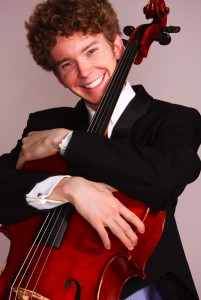 First of all there is Joshua Roman . He is in a class by himself as a musician. He is currently Artistic Director at Town Hall in Seattle, an democratic venue that supports performers in all media and at all stages of their careers.
First of all there is Joshua Roman . He is in a class by himself as a musician. He is currently Artistic Director at Town Hall in Seattle, an democratic venue that supports performers in all media and at all stages of their careers.
Recently, Roman created a two hour plus concert that was all cellos, ranging from a solo by Roman himself performing a newly commissioned work by Mason Bates, to a full component of eight cellists playing together. The cello is an extraordinary instrument, it has the range and textual variation of an entire chamber music ensemble. The program, brilliantly selected, ranged from medieval to the up to the minute Bates, with a full symphony by Brazilian composer Hector Villa-Lobos, an arrangement of Led Zeppelin’s Stairway to Heaven, which followed the Death and Resurrection of an Angel by Astor Piazzolla, and other pieces as well. There was humor in the order of the works, deep variety in the character of the works, and a thrilling evening of music all together.
We are extremely fortunate in Seattle to have Joshua Roman as Artistic Director at Town Hall ( he resigned from cello first chair after two years, he was awarded the seat at the age of 22) The other concerts that he brought to town like Brooklyn Rider and Alarm Will Sound, were also over the top- classically trained musicians performing experimentally. The best of both worlds. Senational!
We also attended some performances at the Shakespeare Festival in Ashland, which is increasingly branching out beyond Shakespeare, while still keeping its core. We saw three wonderfully creative productions, (and a moving Henry V) :
 The White Snake, based on a Chinese Fairy Tale, with stunning staging,
The White Snake, based on a Chinese Fairy Tale, with stunning staging,
a humorous and extraordinary interweaving of Medea, Macbeth and Cinderalla,
 and finally a hilarious The Very Merry Wives of Winsor, Iowa, adapted by Alison Carey from the play by Shakespeare.
and finally a hilarious The Very Merry Wives of Winsor, Iowa, adapted by Alison Carey from the play by Shakespeare.
Each of these plays was uniquely transforming tradition into contemporary theater.
Bringing together “Medea Macbeth and (Rodgers and Hammerstein’s musical) Cinderella” was really crazy. According to Bill Rauch and Tracy Young, who created this odd partnership, this work is a “lifelong passion”. They explain that the themes overlap: “ royal ambition, magic, transformation, parent/child relationships and the roles of women in a male dominated society.” This project lives at the crossroads between populism and experimentation.”
But as the plots crossed and the dialogue was tossed from one story to another, we felt primarily the amazing power of actors to take on such an experimental mélange while maintaining the integrity of each part, heavy and serious in Macbeth and Medea, and clichéd sentimentality in the case of Cinderella. The original plays were all there, except that the characters kept switching from one play to another. The Hammerstein musical numbers were sung by everyone. It was riveting, impossible to take in, and yet also hugely entertaining.
The Very Merry Wives of Windsor, Iowa was a contemporary story, with Senator Falstaff being set up as the fall guy, just as in the original Shakespeare play, in fact it followed the scenes, acts and even dialogue of the original, but it was all contemporary issues (gay marriage for one), and contemporary language couched as Shakespearean ( “ the recycling cometh”) and contemporary people, (and the Iowa State Fair as the grand finale).
Then, back in Seattle, I went to “Words on Water: Indian Writers in Conversation,” at the Seattle Asian Art Museum, three brilliant thinkers who addressed India and Pakistan from strikingly different perspectives.
Three writers were featured: M.J. Akbar, a journalist and Executive Director of India Today,
Nayanjot Lahiri, a scholar of Indus Civilizations and author of Finding Forgotten Cities
and Urvashi Butalia, writer and co-founder of India’s foremost feminist publishing house, Kali for Women and author of the profoundly important book, The Other Side of Silence, voices from the partition of India.
M.J. Akbar was interviewed by journalist Shiraz Sidhva, Nayanjot Lahiri had a conversation with VIkram Prakash, Professor of Architecture at the University of Washington and author of a book on Chandirgarh. But Sonora Jha, Associate Professor in the Dept of Communications at Seattle University took the prize for the most elegantly worded interview in her conversation with Urvashi Butalia.
The most striking aspect of the event was that the three authors presented three very different views of Pakistan. M.J. Akbar, who declared that he was a Muslim, asserted that there are four pillars of modernity: democracy, freedom of faith, gender equality (equality before the law) and economic equity ( meaning avoiding the deep chasm between rich and poor). He declared that Pakistan failed in all four, a concept he also develops in his book Tinderbox.
His analysis of why we are still allied to Pakistan in the “war on terror” was that the US lost its way . He called it the Marshall Petain partner, allied with the Taliban, in an Islamic Space. Petain was, of course, the leader and betrayer of France during Vichy, more loyal to Nazi ideas than to French freedom. Likewise Pakistan, in Akbar’s view, is a failed state because it is based on faith, the idea of a sanctuary for Muslims is not a viable foundation for a modern state.
He also mentioned at the conclusion of his talk that the Islamists were destroying culture in Pakistan created before the founding of Islam in 711, including Mohenjo Daro, the crucial Indus Valley site, and a World Heritage Site that should be protected by the UN. I have not found confirmation of that, but they are destroying other World Heritage Sites, for example in Timbuktu.
Nayanjot Lahiri, as a scholar, spoke at length about the difficulties of deciphering the writing from the Indus Valley Cultures, the important work that had been done in India since Independence in discovering hundreds of new Indus Civiliations sites, and of the crucial work of Pakistani archeologists in their work at the major Indus Civilization sites, all of which are in Pakistan since 1947. When I asked her after the lecture about Akbar’s assertion that Mohenjo Daro was being destroyed by Islamists, she said she didn’t know about it!. Perhaps it is simply being destroyed by erosion and neglect.
But the third speaker really stole the show for me. Urvashi Butalia was engaging, humorous, humble, profoundly engaged and an articulate speaker on the subject of her work in creating the book The Other Side of Silence. Butalia’s own family suffered from the Partition, her mother’s brother stayed behind with his mother in Pakistan and converted to Islam. She herself worked to heal the forty year old wounds of that separation as she bravely went to visit him in Pakistan, and his story starts her book.
But interviews that tell of the painful and horrifying violence against women during the Partition are the heart of the book. For example, one women speaks about dozens of women in a village, including herself, that threw themselves into a well to avoid being violated, but some women survived because there wasn’t enough water to drown them all. This story and others were the basis for some of the paintings by Nilima Sheikh, that I wrote about in my book Art and Politics Now.
Urvashi Butalia declared that Pakistan was a deep part of who she was and of her life, in spite of the restrictions for Indians who went there. Lahiri, as a scholar is studying the common cultural roots of India and Pakistan, Akbar as a journalist has written a book on Pakistan called Tinderbox, which tells of the dangerous conditions in that country today. Three authors, three views. It was immensely enriching to hear these writers, as here in the US, our main information is limited to drone strikes in Pakistan and their random murders.
This entry was posted on July 16, 2012 and is filed under Art and Politics Now, Art of Democracy, Culture and Human rights, economic imperialism vs democracy, Feminism, music, theater.
A few thoughts on Fremont Solstice, We the People and Occupy Living Rooms
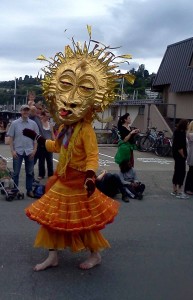 Recently, I have been neglecting this blog. Too many activities, notenough time to think about them. So here are a few
Recently, I have been neglecting this blog. Too many activities, notenough time to think about them. So here are a few
events that I have attended or participated in so far this summer.
We the People Festival followed the famous Fremont Solstice Parade, an outstanding Seattle tradition of crazy creativity and supposedly no politics and everything made by hand. No mechanized vehicles either.
It was a stark contrast to the “Pride” Parade the following weekend, in downtown Seattle. All the groups that I saw were sponsored by corporations and even wearing matching tee shirts with messages.
(the most shocking was Wells Fargo, one of the kings of foreclosures, with marchers wearing tee shirts that read “no place like home.” )
So just being creative as an independent free spirited person is a political act in our current world of corporate control. The act of making wonderful costumes that suggest imagination and humor is already subversive!
In addition politics can imbue a piece without any obvious reference to political issues.
For example, the giant dragon made out of 10,000 plastic bottles was a potent statement in itself.
We the People Festival was not afraid of being political, but we made games about political issues. Apparently the main organizers had met at the Occupy movement in Seattle. So this ongoing creative expression was an outgrowth of that. The event was really extensive, lots of displays and games.There was a “New Economy Game” just next to Gas Works that was a giant board game with all sorts of ideas for local changes that can make a difference.
I made a bean bag toss about rebalancing the budget away from military spending. People said the military budget holes were way too small, those are the oblong shapes (the red line above the toss is part of the very long red line that represented the US military budget in a piece by Fred another participant. But people really enjoyed tossing bean bags into new priorities like funding for green transportation, schools, healthcare and creativity. A simple act, we originally planned it to be more complicated, gave people a real sense of satisfaction, and who knows maybe they went home and thought about the issues a little more. I am wearing my “unarmed civilian” hoodie from “We will Not be Silent” a potent NYC based group of artist activists who constantly infiltrate the street with their pointed signs.
The idea of a bean bag toss was a result of synergy. I started out with a monopoly game idea and it evolved with lots of other people throwing in ideas, into a bean bag toss.
During the planning meetings we made a lot of the games with recycled materials. One of the organizers has a travelling art supply in her car, and she finds materials in all sorts of unexpected ways. Another person works at an event planning business and gets lots of vinyl after the event is over. Hundreds of recycled bottle caps were used in another game. All in all it was a ton of fun and a new way for me to act on my desire to bring together art and politics.
I also had an event in my living room, Occupy Living Rooms: “Something I Can Do: Voices From Occupy Seattle.” Three actors Meg Savlov, Rich Hawkins, and Christine Nyland performed for an audience of about ten people. The prolific and intense theater artist Ed Mast was director and co writer with Christine Nyland. The performance was literally in the middle of my small living room, with the audience sitting on our sofas and chairs, the script lying on the floor in the center of the room. We heard the voices of many different members of Occupy mark the various stages of Occupy from the first idealistic days to the last days of sleeping outside in the rain ( in Seattle’s version) . Of course the movement has now morphed into various separate directions, GMO, foreclosures, student debt.
But there is also an insidious attack on the organizers, accusations and police raids. This is frightening.
This entry was posted on July 14, 2012 and is filed under Art and Activism, Art of Democracy, democracy.
Documentary Photography meets Google Street View and Twitter
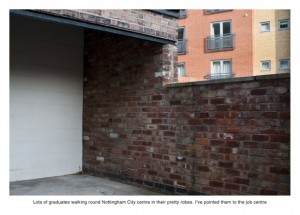
Lots of graduates walking around Nottingham City centre in their pretty robes. I’ve pointed them to the job center.
Two recent shows in Portland featured artists incorporating twitter and Google photographic images, and one exhibition affirmed that traditional photojournalism is just as crucial a practice as ever.
Blue Sky Gallery in Portland, also known as the Oregon Center for the Photographic Arts, showed “No Man’s Land” by Mishka Henner and “Geolocations, Graduates Walking Round” a project by Nate Larson and Marni Shindelman. The first impact of both of these shows is that they are intentionally mirroring the twin realities of pervasive triviality and loss of privacy.
Mishka Henner’s work, based on stills from Google Street View cameras started from reading online male forums discussing the locations of local sex workers, Henner found the locations on Google Street View and downloaded the image of the women there ( with no confirmation that they were actually sex workers) . The women are consistently far away from the camera, photographed from a moving car with a high vantage point, and their faces are blurred out. We have no relationship with them, other than a distant drive by view (elaborated in the accompanying video in the exhibition providing the complete footage of the drive by).
“Geolocations, Graduates Walking Round” was trivial in a different way. Based on Tweets with location coordinates, the artists photographed the location, then paired the tweet with the image. The image seemed inconsequential (like the Tweet), but sometimes, as here, amusing.
I was offended by Mishka Henner’s work, his depersonalized representations of unidentified supposed sex workers. As a privileged male artist, he seemed to be condescending, trite, and exploitative. Many others have pointed this out as well, some even calling for the suppression of Henner’s book. In no case does he identify any of the women or provide any context what so ever for them as sex workers, or the sex worker industry. He simply assumes the position of Google Street View and prints up frames as his copyrighted photography.
His defense of the works is that he feels that eliciting sympathy is “romantic” and a cheap shot, the impersonal view is more contemporary, depersonalized surveillance is what is happening on the planet. He also points out that the subject is a traditional topic for photography, so he is playing off of that history with his work.
He fails completely in my opinion to arouse any response what so ever except that he is an arrogant white guy. He is the real subject of these photographs. There are many artists expropriating images from Google Street View these days, for many purposes. All of them are working with the issue of surveillance, originality, authorship in the age of Google Street View. Miska Henner’s work, because of his topic, becomes simply traditional voyeurism and cruising.
The second exhibition “Geolocations, Graduates Walking Round’ became less mundane in comparison to the work of Mishka Henner. Knowing that these images were actually taken by the photographers, subtle details began to emerge, as well as an intriguingly serendipitous relationship between their triviality as subject, and the triviality of the tweet. They had an abstract, formal quality, an amusing reinvention of modernist aesthetics based on utterly uninteresting subjects – an anti-utopian, heroic impact that completely contradicts the principles of high modernism, even as they have strong modernist references in their compositions.
But poetic absurdity is the main theme. Photographs as locations based on the tweets are actually arbitrarily chosen. Coordinates give 360 degrees of possibilities. The artists selected which way to look, and the direction they chose is tangentially related to the tweet itself, not exactly visually, but in the sense of a certain blankness or dead end f1uality.
My favorite example was “Has gained a new ability today, ability to take a hint.” Here. the three lines dangling from a tarp and the single dot, with the window to the left obviously are a play on Mondrian, and is matched with the tweet. That single dot in the center, that diagonal tie down, could it be we can see Mondrian taking a hint? The modernist aesthetic was cleverly undermined.
Then I went to a third exhibition at the I witness gallery in the Northwest Center for Photography. The photojournalist Leah Nash spent more than a year with five people diagnosed with Asperger’s Syndrome. Four of them are featured in photographs in “A Different Kind of Normal: Stories of Asperger’s Syndrome” and one, a dancer, mother of two, in a video.
We see these people as individuals who are living their lives according to who they are and what they like and what they want to do. They are remarkable photographs and remarkable people. I felt a sense of relief to see these straightforward images, they were not eliciting pity or romance, as Henner so dismissively characterizes traditional photojournalism, they were eliciting respect and even some awe at these individuals. The photographer emphasizes them as people with feelings of love, joy, discouragement, and exhaustion, as well as close relationships with members of their families.
A statement in the show stated that Asperger’s Syndrome as a subset of Autism is being eliminated as a diagnosis. There is no comment on that fact, but if you think that this diagnosis gave all of these people a distinct identity, one can’t help but wonder what the result of taking that terminology away will have on them. Now they will simply be identified as autistic, a diagnosis that includes a broad range of different types of behavior and a diagnosis that is expanding exponentially, from 1 in 10,000 in the 1970s to 1 in 110 today. Asperger’s Syndrome has been defined as “high functioning autism.”
Leah Nash’s photographs not only educated me about Asperger’s Syndrome, they also made me think about the way that people define themselves, the way that society defines them, and how those two interact or contradict one another.
Mishka Henner claimed he did not want people to feel in response to his photographs, he wanted them to think. But the thinking he generated did not really stimulate any larger insights into society, humanity, or the state of the world. It stopped at the cliché that Google Street View is invasive and pervasive.
Nate Larson and Marni Shindelman fall in the middle. Their photographs are intentionally undramatic (although they are aesthetically constructed) , and they make a point about individuals risk of ( desire for?) public exposure (in the tweet, in the location), but they also exist as an act on the part of the photographers to wed those two media in a way that provided some provocative partnerships and a wonderful send up of the modernist aesthetic.
All of these exhibitions point to the fact that documentary photography is in transition as a result of new technologies, but Leah Nash’s work suggests that engaging with individuals is still an indispensable dimension of photography.
This entry was posted on June 9, 2012 and is filed under Photography.
“Hide/Seek” and “Approaching Ecstasy”
At the beginning of the exhibition Hide/Seek, Difference and Desire in American Portraiture, which I saw at the Tacoma Art Museum(it is up until June 10) we are immediately captured by a painting of a nude woman from the waist up, her full breasts swelling and her nipples hard, in deep shades of pink. The woman’s face suggests some detachment, but her physicality almost jumps out of the frame.
Astonishingly, this is an early work by Agnes Martin, an artist who became famous for paintings of abstract lines and colors so subtle that you could barely see them. She tried to destory all of her early works. This nude’s assertiveness declares desire (perhaps thwarted). It offers an explanation for the deeply withdrawn mature works. No matter how many elegies are written to those horizontal penciled lines on a beige surface, they remain, for me, an absolute rejection of physicality, of the world, of love. Martin lived as a recluse. She developed her minimalist abstractions in New York City in the early 1960s, a time dominated by aggressive men and continued them, after a hiatus of a few years, for the rest of her life.
The examples from the late nineteenth and early twentieth century in Hide/Seek, Difference and Desire in American Portraiture, particularly fascinated me. In those years being homosexual was dangerous and illegal ( as witnessed in the famous case of Oscar Wilde), except among the wealthy in Paris. Berenice Abbott photographed some of the famous women of that time, like Janet Flanner and Djuna Barnes. These photographs are old friends. We feel that we are sitting in the room with these women. But we also know that they all made crucial contributions to culture as journalists, poets, writers, visual artists. Abbott’s photographs approaches them as individuals who are entirely comfortable with themselves.They were first immortalized as a group by Sheri Binstock’s wonderful book Women of the Left Bank.
The austere self portrait of Romaine Brooks is still the defining lesbian image of that Paris era. We know of so many extraordinary women who are not included in Hide/Seek who can be encompassed by this amazingly androgenous, male identified black suited, white shirted top hatted Brooks.
I am thinking particularly of Jane Heap about whom I have written two articles as the extraordinary editor of the Little Review in the 1920s. She was photographed by Berenice Abbott in a tuxedo and bow tie. Her absolutely engaged penetrating look as well as her swaggering posture, suggests her defiance, her status as a person who, according to her magazine’s slogan, “made no compromise with the public taste.” At this time, she had already published the first chapters of James Joyce’s Ulysses in her magazine and been sued for libel. in the United States. She was, in 1922, being taken up by the Paris avant-garde as a hero.
Abbott went back to NYC and in the middle of the 1930s she fell in love with Elizabeth McCausland, the extraordinary art critic and another subject of one of my articles. Here you see her as an adoring young writer, on the right , with Gertrude Stein in 1934, following the presentation of Stein’s Four Saints in Three Acts in Hartford, Connecticut. As I discuss in my article and my book on the 1930s, McCausland wrote eloquently and passionately about Four Saints, focusing mainly on the score by Stein, in one of her newspaper columns for the Springfield Republican.
Both McCausland and Abbott joined the political left in NYC, as defined a society as Paris of the Left Bank, only in the 1930s sexual identity was superceded by fighting fascism, the Popular Front, and the American Artists Congress, as I discuss in detail in my book, Art and Politics in the 1930s.
But to return to the artists of Hide/Seek, John Singer Sargent’s 1895 painting of his male servant relaxing nude on a sofa is one of many that we have never seen, no matter how familiar we are with Sargent’s sumptuous watercolors and seductive society portraits.
Likewise Grant Wood’s Arnold Comes of Age of 1930 tells us about Wood beyond American Gothic, at the same that it sheds light on that so familiar work.
Lincoln Kirstein in Dorm at Harvard by Walker Evans reminds us that most of the prominent artists and curators of that era were friends at Harvard (Alfred Barr was there too, just a little earlier) and many of them closeted. Kirstein was to be so profoundly important in twentieth century culture in the world of dance, that we treasure looking at the intelligent and concentrated young man in this photograph and knowing his future.
The theme of Hide/Seek is “How Gender and Sexual Identity Have Shaped Modern American Portraiture.” It was curated by Jonathan D. Katz and David C. Ward with the purpose of “tracing the evolution of sexual identities.” The scope of the exhibition is actually greater than that. Most of the people who created the images and most of the people represented in the art are all extraordinarily important to American cultural life in the last 120 years.
For example, there is Thomas Eakins’ stunning photograph of an aging Walt Whitman, from 1891, an iconic image, of one great artist by another.
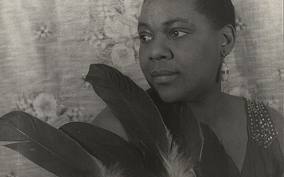 Of the same marriage of artist and subject, is Carl Van Vechten’s photograph of Bessie Smith. the great blues singer. Vechten captures Bessie, not as the confident performer, but as a woman sadly gazing at her demons.
Of the same marriage of artist and subject, is Carl Van Vechten’s photograph of Bessie Smith. the great blues singer. Vechten captures Bessie, not as the confident performer, but as a woman sadly gazing at her demons.
Alice Neel’s portrait of Frank O’Hara, the great poet and art critic, in profile, suggests his central place in New York City’s cultural life of the mid century.
These artists admired one another for their brilliant creativity. In some cases they shared a common community, in others, they created their own entourage, as with the well- known example of Andy Warhol represented in Hide/Seek, by a stunning camouflage self portrait in brilliant shades of red and magenta, that calls attention to Warhol as one of the first absolutely uncamouflaged gay artists, as well as one of the most closeted people in terms of his art and its intentions. This flame- like headdress seems to underscore that contradiction. He looks down, escaping our direct gaze, unlike the riveting defiant expression of, for example, Jane Heap.
The exhibition continues through to the present, with the shattering outbreak of AIDS in the late 1980s and through the 1990s, that tragic watershed in American cultural life and activism. The current century is only briefly represented. With good reason: as in the 1930s, the centrality of identity is again being eclipsed by pressing political concerns and gay rights seems to have become primarily a national focus on marriage.
But these artists and their subjects, were often not about sexual identity either, with some exceptions like the wonderful Tee Corinne, whose work I was so glad to see included here. Tee reveled, like Jane Heap, in defying norms, and explicitly representing exactly what she wanted to in her drawings. 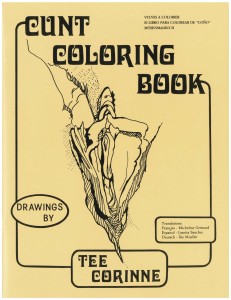
These artists are all about creativity, at a time when that frequently meant marginalization. Many radical artists, writers, musicians, playwrights, and dancers were and are gay. Being gay gives an intense understanding of what injustice feels like (still). They extend that awareness into many directions.
Part II Approaching Ecstasy
That is the case with the phenomenal Approaching Ecstasy, a dance collaboration composed by Eric Banks and choreographed by Olivier Wevers based on the poetry of Constantine P. Cavafy, a Greek who lived most of his life as both a bureaucrat and a closeted homosexual in Cairo in the early 20th century.
Approaching Ecstasy premiered at the Intiman THeater in Seattle in May 2012. Hopefully, it will be performed again and again.
The musicians and singers wore black suits with bowler hats a la Rene Magritte, while the dancers of the group Whim W’him, escaped in various ways from the closet, both literally and figuratively (the only set was a folding metal frame that could be 2 or 3 dimensional, a mirror, a room, a building, a closet, or a wall.
As the 40 members of the Esoterics, accompanied by St Helens String Quartet, plus a harp, sang the lush sexually specific poetry of Cafavy in both Greek and English, we were transported to a place of liberation, of extraordinary multimedia poetry in sound and movement.
Emerging out of darkness into light was also a crucial aspect of the staging designed by Jeff Forbes. The collaboration was much more than the sum of its parts, just as the portraits of Hide/Seek are more than the sum of their identities. I was fortunate to see these two expressions of creativity in one day.
One poem by Cafavy (translated by Eric Banks)
Senses (1912)
Return to me often and take me,/O senses that I love, return and take me: /Then my body will awaken, /And the cravings I once felt will flow in my blood again; /Then my lips and my skin will remember,/ And my hands will understand how to touch once more. /Return to me often and take me, in the night, /Then my lips and my skin will remember.
Cafavy is best known for his poem “Waiting for the Barbarians” which never seems to stop being an insightful commentary on contemporary politicians. But knowing this poem so well, as well as so many of his other poems, made the exclusive emphasis on his sensual love poetry all the more compelling. As with the case of the John Singer Sargent and Grant Wood paintings in Hide/Seek, bringing together the man in more than the sum of the parts that we know enriches our appreciation of what creativity means and expands our understaning of their humanity.
Waiting for the Barbarians” by Constantine Cafavy
“What are we waiting for, assembled in the forum?/The barbarians are due here today./Why isn’t anything happening in the senate?/Why do the senators sit there without legislating?/Because the barbarians are coming today./What laws can the senators make now?/Once the barbarians are here, they’ll do the legislating./Why did our emperor get up so early,/and why is he sitting at the city’s main gate/on his throne, in state, wearing the crown?/Because the barbarians are coming today/and the emperor is waiting to receive their leader./He has even prepared a scroll to give him,/replete with titles, with imposing names/.Why have our two consuls and praetors come out today/wearing their embroidered, their scarlet togas?/Why have they put on bracelets with so many amethysts,/and rings sparkling with magnificent emeralds?/Why are they carrying elegant canes/beautifully worked in silver and gold?/Because the barbarians are coming today/and things like that dazzle the barbarians/.Why don’t our distinguished orators come forward as usual/to make their speeches, say what they have to say?/Because the barbarians are coming today/and they’re bored by rhetoric and public speaking./Why this sudden restlessness, this confusion?/(How serious people’s faces have become.)/Why are the streets and squares emptying so rapidly, /everyone going home so lost in thought?/Because night has fallen and the barbarians have not come./And some who have just returned from the border say/there are no barbarians any longer./And now, what’s going to happen to us without barbarians?/They were, those people, a kind of solution.”
This entry was posted on May 31, 2012 and is filed under Art and Politics Now.
A Visit to Maquiladoras in Tijuana
I was able to visit a few maquiladoras with Fred Lonidier, activist, artist, UCSD professor ( above), who has been working with workers rights issues at these factories since the early 1980s. He invited me to lecture to his class at UCSD. Our first stop after the lecture was the Che Cafe. In the center is Rigoberta Menchú. This is Fred’s photograph with me in the foreground joining these heroic women. The cooperative cafe has survived a lot of challenges to its existence by UCSD administrators.
The next day we went to the East Tijuana industrial district via the crossing at Otay Mesa.
Gloria Anzaldua eloquently characterized the border as “Una herida abierta” (an “open wound”) where the Third World grates against the First and bleeds. And before a scab forms it hemorrhages again, the lifeblood of two worlds merging to form a third country – a border culture. … a borderland is a vague and undeterrmined place created by the emotional residue of an unnatural boundary.” Gloria Anzaldua, Borderlands/La FronteraThe New Mestiza, (1987,1999)
According to Fred, corporations have been playing games since the late 1960s with the free trade idea originally with an old promise of twin factories, one in US, one in Mexico. Only the US half usually didn’t happen.The free trade area used to extend 20 miles to the South of the border, but with NAFTA the whole country is now a free trade zone
It is much easier to work outside health and work regulations in Mexico.
These factories manufacture many household goods including televisions, furniture, mirrors, eyeglasses ( think Zeiss), and now electronics, especially high tech hospital equipment.
Workers have fought abuses at these factories for decades and it is ongoing to this day. Organizing is more difficult because of the disparate character of the communities which consist of people from all over Mexico who have neither familial nor ethnic bonds. New relationships have to be forged.
Groups like the Environmental Health Coaltion, based in San Diego/Tijuana and Coalition for Justice in the Maquiladoras an umbrella group work for justice in the maquiladoras for workers and call for justice against women who ” suffer discrimination, humiliation, and sexual harassment in the workplace.”
Before we saw the factories,we went to a muddy lot (above) where many squatters used to live. Only a few are left at this location today.These squatters are living in the midst of toxic run off from factories, they have no services at all, no electricity, no sewage, nothing. They are newly arrived people from other areas of Mexico, who start here and sometimes work their way up to having a house in a “colonia” which actually does have city services from Tijuana.You can see one electrical wire in the photograph.
We even saw middle class homes (and middle class youth): these are the homes and children of the supervisors of the factories, or the more skilled engineers and technicians.
The majority of workers are making small electronic devices, with repetitive motions. Back when Gloria Anzaldua first wrote about the factories they were making cassette tapes. Today they are making hi tech electronics, the reason why so many women are employed – it requires delicate manual dexterity. But from then to now, the workers have been exposed to toxic substances that go into the consumer products that they make. Exposure to toxins is in the factory itself, and then it follows them home as the run off from the factories pours out of open pipes.
Then there is the question of labor unions, the topic that Lonidier has addressed in various ways in his important work. Lonidier has been bridging the (considerable) gap between labor unions and visual art with his work, making visible in his sophisticated, but also entirely understandable, photograph-text pieces, the struggles of workers for better working conditions. He also shows his work in both union halls and art galleries. Here is a review of a recent show he held in an art gallery.
The wages of maquiladora workers are abysmal, as low as $8. a day, there are no safety precautions ( a topic that Londier is known for from a 1979 work that is gaining new attention recently, suggesting how important it still is.)
If the workers try to organize a real democratically run union, the “company union” representative is sent to the meeting to calm everyone down.When the workers return to work, the organizers get fired. Fred took me to one site of a victory, where a badly contaminated site had finally been sealed by the government after, as he said, years and years and years of hearings and protests. Naturally the government now takes credit.
The recession has hit this area hard, and many workers have been laid off. We in fact saw very few workers even at lunch time, when normally they would have been thronging the food stands. Apparently, the newer factories now provide lunch in the factory, probably at a deduction from a meager pay check. Plus of course, a chance for a change of pace and environment is lost.
The new factories are fortified with big fences and guards, who called their bosses as soon as we paused to take a picture. The older factories are more on the street, with a less militant atmosphere.
I also saw the actual border fence as it is in this part of Tijuana- several electrified fences with surveillance lights and razor wire. In Tijuana’s main crossing it goes right into the ocean.
Fred also took pictures of me photographing it.
After visiting Tijuana, we went to the Centro Cultural de la Raza in San Diego where there was an exhibition called La Hermanidad ( Brotherhood) about workers of all backgrounds united in struggle. The building has murals all over it and even spreading into the park around it.
The exhibition included work by David Bacon ( stunning website) , Fred Lonidier, and works honoring people who have been lost at the border.
Last we visited Chicano Park, which has murals painted on the freeway supports. It has been going for quite awhile and now the murals are actually being restored. I met Victor Ochoa, one of the important muralists there. That’s his mural of Revolution with Zapata, the inspiration for the uprising of the peasants then and now. The second mural says the earth belongs to those who work it with their own hands.
Most of the murals were nationalist in flavor, looking to the culture of Mexico, the Revolutionary era in Mexico, and other inspiring subjects. They are also about farm workers issues which of course are on going and, if anything all the more urgent today.
One of Fred’s students, Amy Sanchez, an art historian is collaborating with Misael Diaz, an artist, on a border project called Cognate Collective. They have a small shop space in Tijuana, near the border, and they are encouraging indigenous women in particular to make embroidery as well as other projects related to clothing.The indigenous women are from all different backgrounds. This is one of the painful aspects of the massive dislocations going on in Mexico as a result of free trade.
I want to end with this great photograph Fred took of me slipping in the mud as I left a toxic area. It seems to capture how slippery information is about maquiladoras.
This entry was posted on May 11, 2012 and is filed under Art and Politics Now.

